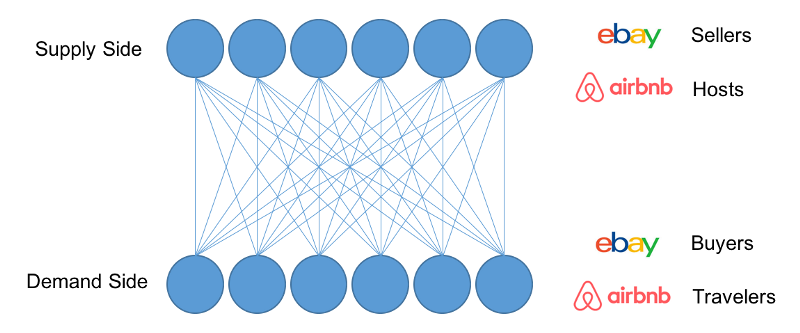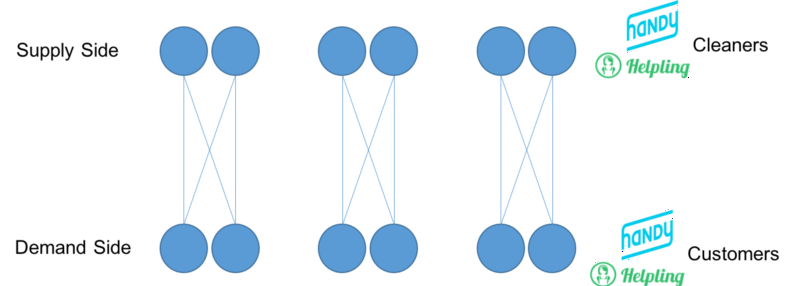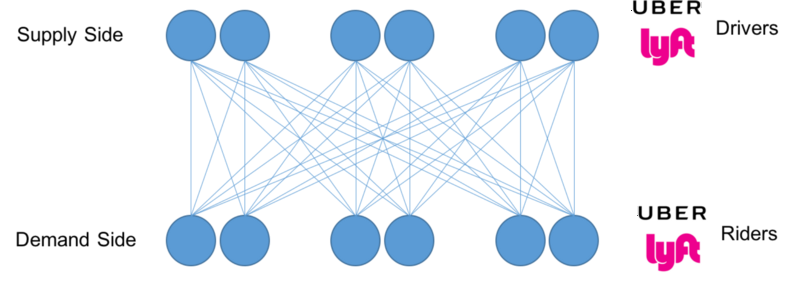What Kind of Marketplace Are You Building?

Last month, I was mentoring the teams participating in the AngelHack Hackathon, and as in most similar events, there were many Marketplace ideas.
Online Marketplaces have been around since the early days of the Internet and have widely proven to lead to extremely successful and scalable businesses.
They evolved from the initial horizontal model made famous by eBay and Craigslist, where practically anything could be traded, to various vertical models optimized for specific categories and focused on better serving customers’ needs in those categories; e.g. “Cleaning”, “Rental”, “Laundry”, “Ridesharing”, …
There is a good piece by Jeff Jordan “People Marketplaces” that covers well the “Vertical vs. Horizontal” question:
“Our hypothesis is that the horizontal plays may suffer from a potential “paradox of choice”: Consumers could be getting overwhelmed by the seemingly infinite array of potential service options presented by horizontal platforms, but consumers can easily understand the highly specialized value proposition of a company offering services in one vertical”
and
From a product perspective, the vertical apps can tailor their workflow to the unique characteristics of that vertical — the best way to find someone to clean your house is different than the best way to find a ride.
However, regardless of whether the marketplace follows a vertical or horizontal model, other differentiating elements make some more likely to be hugely successful than others.
In the best situation, anyone from the demand side should be able to tap into anyone or anything available on the supply side. That’s the case, for example, with AirBnB. They have a high liquidity and a strong Network Effect. Every new user makes the marketplace directly more valuable for everyone else. Moreover, potentially every guest can be a host and every host can also be a guest. This is, in a way, the ideal type.
On the other end of the spectrum, there are examples such as Helpling, former Homejoy, and Handy that offer home cleaning and maintenance services. In those cases, multiple and distinct supply and demand sides have to be built and scaled, not only in every city but also, in every neighborhood. The reason being that, for instance, it makes little economical sense for a cleaner to accept a job from a customer living in a far away part of a city. Transportation cost and commute time would offset a large part of, if not all, the profit. At the same time, a customer would only need the service when at home and therefore would never tap into the available supply of cleaners in other cities even when traveling to those same towns.
This type is, kind of, a “Collection of Marketplaces” rather than one single large Marketplace. Although it can still turn into a successful company, it is much harder to build and scale. Indeed, it has less overall liquidity and a relatively weaker network effect. So the Egg/Chicken problem, common to all marketplaces, is even harsher. Consequently, it takes a longer time and requires more resources to reach a critical mass and maintain growth.
Somewhere in-between the two previously described types, there is a third one. Most famous examples are Uber, Lyft and similar ride-sharing services.
In this third type, there is still a need to build multiple supply and demand sides in different geographical locations for the model to work. However, the advantage, in this case, is that supply can move around and benefit from the available demand in other areas. E.g., drivers can choose the region where they want to work depending on the time of day and the day of the week. Similarly, customers can take advantage of different available supplies by requesting rides in various areas both inside and outside the city and also when visiting other countries. So even if multiple supply and demand sides have to be built, they are not completely segregated as in the case of a “Collection of Marketplaces”. Subsequently, this type is relatively close enough to a single large Marketplace type and still benefits from a similar strong network effect.
To summarize:
Type-1 is one large Marketplace where anyone from the supply side can trade and interact with anyone from the demand side. E.g., eBay, AirBnB. In these two examples, there can even be an overlap between the supply and demand sides. A seller can also be a buyer, and a buyer can also be a seller.

Type-2 is a “Collection of Marketplaces” where distinct supply and demand sides have to be built. Each subset of the demand side only trades and interacts with its corresponding subset of the supply side. E.g., Handy, Helpling.

Type-3 is an in-between hybrid type where multiple supply and demand sides still have to be built but where each subset of the demand side is not limited to only trade and interact with its corresponding subset of the supply side. Here, the different supply sides and the various demand sides can interact with each other as well. E.g., Lyft, Uber.

For anyone building an Online Marketplace, one of the key questions to consider is:
Does the service you want to offer require one large Marketplace (type-1 or type-3) or rather a “Collection of Marketplaces” (type-2)?
Both can lead to successful outcomes. Though, the latter is much harder to build, takes a longer time, requires more resources and is much more difficult to scale.
Now, beyond the overall types, the “Vertical vs Horizontal” question and the Egg/Chicken problem, there are some additional subtle aspects to consider.
Convenience vs. Value
Simply put, ask yourself if the service offered is a “nice to have” convenience, something of actual value, or both?
This is covered in the same post by Jeff Jordan:
It appears that the early breakouts in the space are those that offer both convenience and value. It’s clear that the market size of people who are willing and able to pay a premium for convenience is much, much smaller than those who are attracted to both convenience and value. For example, a service that charges a premium to come to you to wash your car may work well on Sand Hill Road, but it’s unlikely to have broad national appeal and disrupt the physical car wash industry.
Personal vs. Impersonal Interaction
There are significant differences in the depth of interactions across the various categories.
When it comes to services such as transportation, whether a customer knows the driver or not and the fact that for each ride a different driver will most likely show up, don’t matter much.
Some drivers/riders can be more chatty/friendly than others but overall the total customer experience is very little impacted by the depth of interaction as long as the transportation service is properly delivered.
In contrast, for services such as “Pet Sitting” and Babysitting, the interaction becomes more personal and the level of affinity and trust the customer has with the person providing the service matters tremendously. In situations like these, there is a strong tendency for customers to prefer dealing with the same person everytime.
This brings additional challenges that could lower the overall liquidity and cause Platform leakage.
Platform Leakage
This is when transactions start occuring outside the marketplace via a direct interaction between the two parties.
In the Babysitting example, once the first matching is done through the platform, there is a possibility that the subsequent requests and payments are arranged directly between the two parties.
Customers may use the platform again to get matches with some additional Babysitters but once a personal relationship is established with a handful of trusted providers, there are less incentives to go back to the marketplace.
One way to solve that problem is to provide some value in addition to the matching and transaction processing.
For instance, “Pet Sitting” marketplaces offer an insurance with generous coverage in case something happens to the Pet or if the Pet causes a damage to the sitter property.

Marketplaces are hard to build. Nowadays, creating the product is, by far, the easiest part. The toughest work is what happens next.
Being aware, upfront, of the different types, models and their underlying constraints will make whomever wants to start a business in this space better equipped to ask the right questions and think about which strategies to adopt before jumping into the long entrepreneurial journey.



